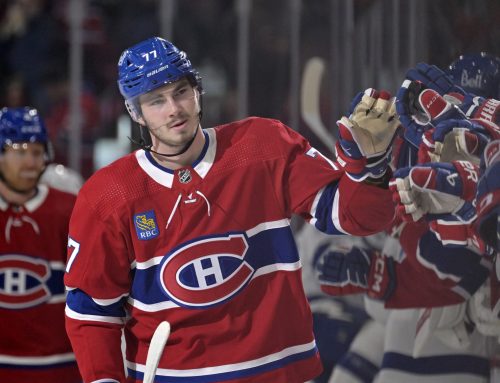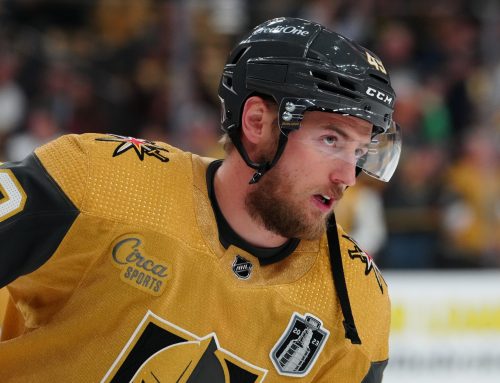Frozen Tool Forensics: Breakout Thresholds and Pettersson, Suzuki, Thompson, and Others
Chris Kane
2022-08-26
Usually in the summer I like to take a look at our fourth-year breakout reports and get an idea of which players are in position to take that step forward. This year I am going to adjust the process slightly based on a recent article that uses games played to measure a player's breakout threshold.
This week on Frozen Tool Forensics: Players on the Breakout Threshold.
The full article was posted on June 30th and is a good read so definitely go check it out. The brief summary is that there tends to be a game count by which players start to break out. In this case breakout is defined as a 25 percent year-over-year increase. What they found is that average size forwards need about 200 games, and D and exceptionally small, or larger forwards need about 400 games. Please go check it out for more details, but one section in particular caught my attention.
"It’s always a great indicator if you see that a player finishes the previous season with 230 or 240 career games and he just enjoyed a very strong second half. When you see that, then feel confident in a potential breakout for the year ahead."
Here are a couple of variables that we can actively filter and sort for. With the right table or reports we should be able to pull that information together and get a list of players who meet this criteria. According to this research it should be a list of players poised to do good things next year. The article also makes clear that these are all generalities, and there are definitely exceptions, but it made me very interested to see who might be on this list.
So how to pull together this data? Well, we already know that we can run custom reports for the regular season, so if we pick a mid-point date (in this case I used Jan 15) we can get point paces for players prior to and after that date. Looking at the difference there we can get a list of players who had a stronger second half than first half. There wasn't a direct report for career games played, but with a little creative filtering on some longer term reports you can make it work.
Once I exported the reports that had the data I needed I could combine them for a custom table for filtering. Apply the games played and point pace criteria and we get a list of eight names.
| Name | Pos | Team | Total GP | Per Game PTS 1st Half | Per Game PTS 2nd Half | Δ in Splits |
| ELIAS PETTERSSON | C | VAN | 245 | 0.5 | 1.2 | 0.7 |
| NICK SUZUKI | C | MTL | 209 | 0.5 | 0.9 | 0.4 |
| TAGE THOMPSON | C | BUF | 223 | 0.7 | 1 | 0.3 |
| MATHIEU JOSEPH | R | OTT | 232 | 0.3 | 0.6 | 0.3 |
| ROOPE HINTZ | C | DAL | 239 | 0.8 | 1 | 0.2 |
| TREVOR MOORE | R | L.A | 204 | 0.5 | 0.7 | 0.2 |
| ROBERT THOMAS | C | STL | 241 | 1 | 1.1 | 0.1 |
| CONOR GARLAND | L | VAN | 241 | 0.6 | 0.7 | 0.1 |
This is certainly an intriguing list. Some of these players already saw quite a bit of success in 21-22 so might not be prime candidates for another breakout, but we will get to that in a minute. What we really want to know though is what we might be able to expect from these players. If we assume that this list has a higher probability of hitting that breakout status that means we are hoping these players will put up at least 25 percent more points in 22-23 than they did in 21-22. That means we need to add some pace data to our table.
| Name | Pos | Team | Total GP | Per Game PTS 1st Half | Per Game PTS 2nd Half | Δ in Splits | 21-22 Pt Pace | Proj 22-23 Pt Pace |
| ELIAS PETTERSSON | C | VAN | 245 | 0.5 | 1.2 | 0.7 | 70 | 87.5 |
| NICK SUZUKI | C | MTL | 209 | 0.5 | 0.9 | 0.4 | 61 | 76.25 |
| TAGE THOMPSON | C | BUF | 223 | 0.7 | 1 | 0.3 | 71 | 88.75 |
| MATHIEU JOSEPH | R | OTT | 232 | 0.3 | 0.6 | 0.3 | 36 | 45 |
| ROOPE HINTZ | C | DAL | 239 | 0.8 | 1 | 0.2 | 74 | 92.5 |
| TREVOR MOORE | R | L.A | 204 | 0.5 | 0.7 | 0.2 | 50 | 62.5 |
| ROBERT THOMAS | C | STL | 241 | 1 | 1.1 | 0.1 | 87 | 108.75 |
| CONOR GARLAND | L | VAN | 241 | 0.6 | 0.7 | 0.1 | 55 | 68.75 |
The other consideration for this list is size. Most of the list fits the average forward criteria laid out in the article, but there are a couple of caveats. Tage Thompson at 6'7'', 218 is not an average size forward. The model would typically expect him to take closer to 400 games to break out (additionally he has already sort of broken out, but we will get back to that in a minute). Both Conor Garland and Roope Hintz are sort of borderline here too, Hintz is reportedly an inch taller than the average category, and Garland an inch shorter. I am going to keep them in though as I think we can take all of this with a grain of salt.
So let's dig into some players.
First up – since we have mentioned him already, let's finish the Tage Thompson discussion. As listed above he is a bit of an odd man out, not only because he doesn’t fit the general size profile, but 21-22 was a significant breakout already. He put up a 71-point pace when his previous high was a 30-point pace. This isn't me trying to say that a lot of it wasn't legit either. He saw an increase of more than three minutes of total ice time, more than a minute of that being power-play time. Not coincidentally he also increased his shot per game numbers to well over three per game, and saw an increase in his expected goal numbers. The slight issue I do have though is that his inclusion on this list implies he could see yet another increase theoretically up to a 90ish point pace. That seems a little less likely given that some of his 70-point pace can be attributed to a chunk of luck. His personal and team five-on-five shooting percentages were quite high, meaning he and his teammates were scoring more often than should be expected in the future, and his secondary assist rate was pretty high, meaning he was getting in on more of those goals than we might expect in the future. Being on this list puts him in good company, but if nothing else changes he is going to be hard pressed to maintain the 70-point pace, let alone increase it. The one caveat here (and this is partially what the model is predicting) is time on ice. Part of why players breakout in these time frames is that they are being put in better positions to succeed than they have previously so past data won't capture that. Or put more simply, it often means more overall ice time, and more power-play time. If Thompson were to add another minute plus of power-play time and bump his overall ice time closer to 19-20 minutes a night, he could be looking at continued breakout status.
Similarly, I wanted to touch on Robert Thomas. His second half wasn't necessarily a lot better than his first half, but he was incredibly solid all season. His 87-point pace beat his previous career high by 35 points. As with Thompson, Thomas being included on this list means he might be considered an excellent candidate for further breakout and the estimate puts his point totals up over 100. So much of what was true for Thompson is true here too. Thomas saw over 18 minutes a night on average, up more than five minutes a night from 19-20, and 30 seconds of it coming on the power-play. He shot more per game and improved his expected goal numbers. He also had a pretty high personal and team shooting percentage. There is a lot to like about a repeat point per game season from Thomas, but to see another jump he would need to see another deployment change as well. He only saw just over two minutes of power-play time on average so that is a clear area where he could see some growth.
This brings us to two players who seem to fit this model to a 'T'. Elias Pettersson and Nick Suzuki had significant bounce backs in the second half of their seasons, are within the expected size range for the model, and have shown flashes of brilliance at other points in their careers.
Pettersson, who has shown high point upside in the past, might not be on this list at all if it weren't for his terrible start to the season. He has already put up between a 70- and 80-point pace three times in his career, so 'breakout' might seem an odd word, but at least let this serve as your reminder that we had been expecting bigger and better things from him. His shortened 20-21 and slow start in 21-22 might have dampened expectations, but he was putting up close to a 100-point pace over the back half of 21-22. By that standard the 90ish point projection for 22-23 might even seem low. His games played count has been interrupted by injury, so that is obviously still a concern here too.
Suzuki, like a lot of Montreal, was a different player once Martin St. Louis took over the coaching gig in Montreal. His overall pace was pretty similar to 20-21, but was almost a point per game in the second half of the season. Overall he was getting a ton of ice time, and his underlying numbers were a touch low, but nothing too unusual. Relying just on those to bounce back would result in a small improvement, but not the kind of 25 percent improvement we have been talking about thus far. In Suzuki's case an improved point pace seems very reasonable, though a 25 percent increase might also require him taking another personal step forward as a player.
That is all for this week
Do your part to support organizations working to make hockey for everyone.





 TOR
TOR BOS
BOS DAL
DAL VGK
VGK EDM
EDM L.A
L.A COL
COL FLA
FLA T.B
T.B VAN
VAN WPG
WPG NYR
NYR
